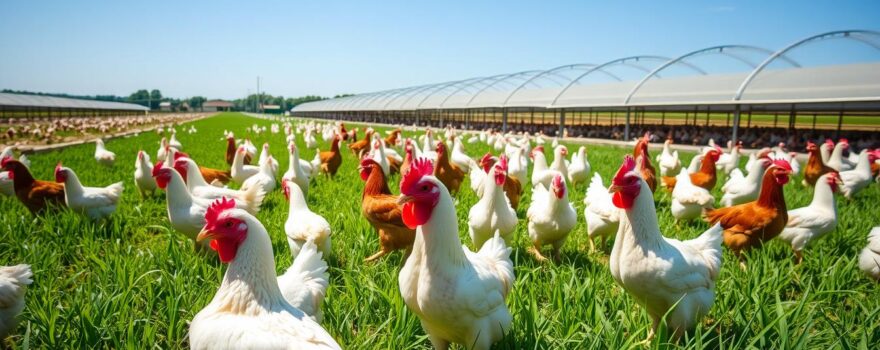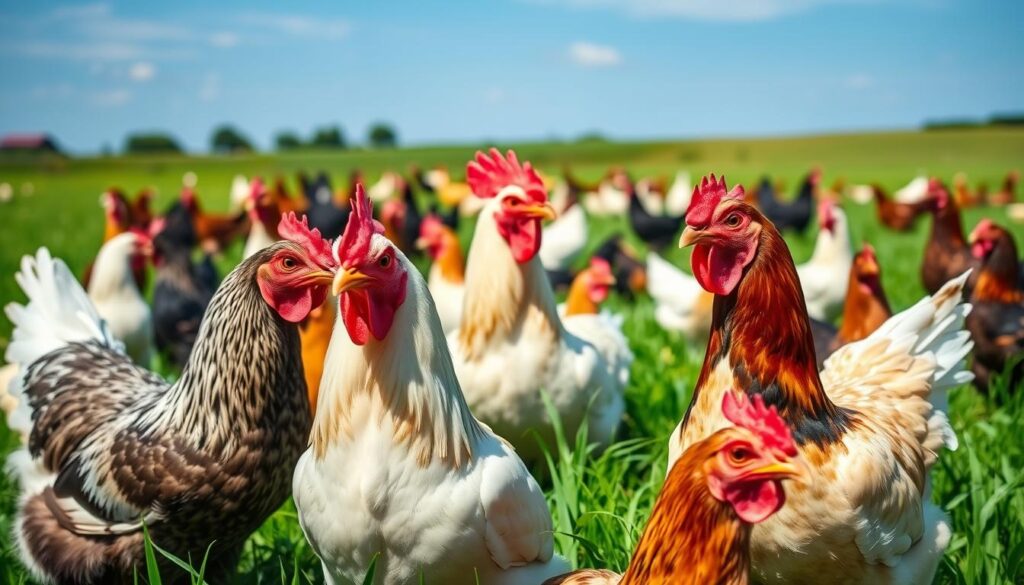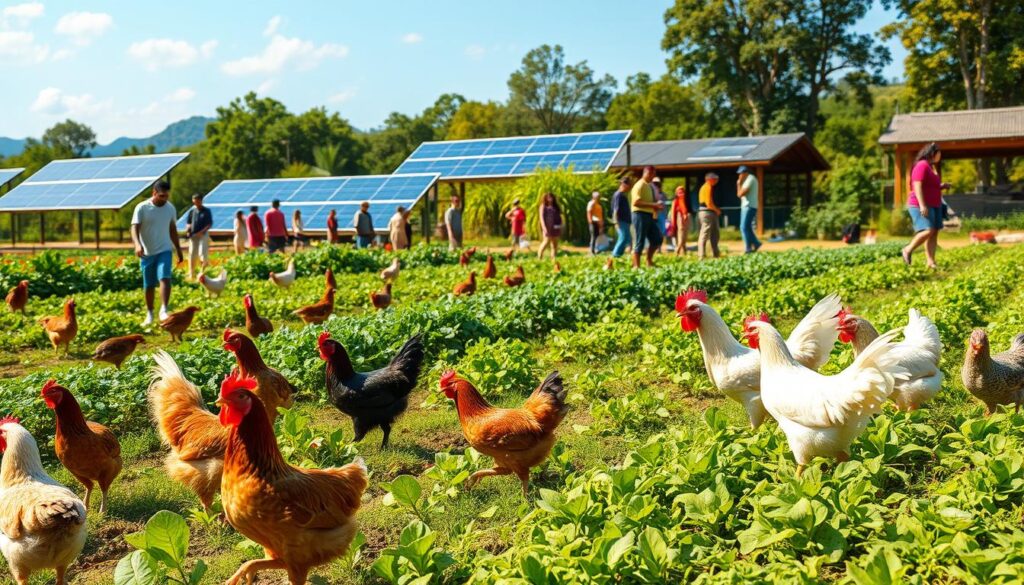
The world’s population is growing fast, and we need more food. Broiler chickens are a key answer to this problem. They are raised just for meat and are very good at it. They help us feed more people in a way that’s good for the planet.
Key Takeaways
- Broiler chickens play a crucial role in meeting the growing global demand for protein.
- Poultry farming provides a sustainable and efficient means of meat production.
- Broiler chicken breeds are specifically tailored for optimal meat yield and quality.
- Intensive livestock practices, such as automated facilities and controlled growth conditions, contribute to the industry’s productivity.
- Broiler chickens are a vital component of global food security and sustainable consumption practices.
The Role of Broiler Chickens in Feeding the Growing World Population
The world’s population is growing fast, making it key to find nutritious and easy-to-get food. Broiler chickens, raised just for meat, are key in this search. They grow quickly, use feed well, and adapt to many climates. This makes them a solid choice for big protein needs.
Broiler chickens do well in many settings, from small farms to big industrial farms. This lets them produce a lot of chicken meat efficiently. It’s also cheaper and easier to get than other meats. Plus, they use feed well, which helps in making meat production more sustainable.
Broiler chickens help meet the world’s food needs, especially as the population grows. They grow fast and give a lot of meat from little feed. This makes them a good choice for farmers wanting to produce more with less environmental harm. As the world faces the challenge of feeding more people, broiler chickens will become even more important.
“Broiler chickens are a crucial component in ensuring global food security, as their efficient and scalable production can provide an abundant and affordable source of protein to meet the world’s growing nutritional needs.”
Poultry Farming: A Sustainable Solution
Poultry farming, especially for broiler chickens, is becoming a key way to meet the world’s meat needs. Broiler chickens have efficient feed conversion ratios and a low environmental impact. This makes them a great choice for producing lots of affordable protein.
Efficient Feed Conversion
Broiler chickens are amazing at turning feed into meat. They need less feed to grow than other animals. This means lower costs and a smaller environmental footprint for poultry farming.
Low Environmental Footprint
The poultry industry has a lower environmental impact than other meat production. Broiler chickens produce fewer greenhouse gases and need less land, water, and resources. This makes poultry farming a sustainable meat production choice, helping the environment.
“Poultry farming is a key component in the shift towards more sustainable meat production to feed the world’s growing population.”
The poultry industry is crucial in providing a sustainable solution for protein. As the world’s population grows, poultry is ready to meet the demand. It does so with less harm to the environment.
Broiler Chicken Breeds: Tailored for Meat Production
In modern poultry farming, broiler chicken breeds are designed for meat production. They grow fast, convert feed well, and produce quality meat quickly. This is different from traditional chicken varieties.
Broiler chickens’ success comes from their genetics. They focus on muscle growth and fat, leading to bigger, more meaty bodies. This makes them key in intensive farming, helping feed the world’s growing population.
| Broiler Chicken Breed | Average Live Weight | Feed Conversion Ratio | Meat Yield |
|---|---|---|---|
| Cobb 500 | 2.5 kg (5.5 lbs) | 1.75 | 75% |
| Ross 308 | 2.7 kg (6 lbs) | 1.65 | 77% |
| Hubbard F15 | 2.4 kg (5.3 lbs) | 1.80 | 73% |
These breeds are the heart of the modern poultry industry. They meet the world’s demand for affordable meat efficiently.

“Broiler chickens have been engineered to grow twice as fast as their ancestors, allowing for a more efficient and productive meat production process.”
The world’s population keeps growing, making broiler chickens crucial for protein. They are a vital part of the global food system, ensuring we can feed everyone.
Intensive Livestock Practices
The broiler chicken industry uses intensive livestock practices to meet the growing demand for meat. These practices include automated facilities and advanced feeding systems. They also control the environment to optimize chicken production.
Automated Facilities
Modern broiler chicken production facilities are highly automated. They use state-of-the-art equipment to streamline operations. These facilities include:
- Automated feeding and watering systems that ensure a consistent and balanced diet for the birds
- Climate-controlled environments that maintain optimal temperature, humidity, and air quality
- Automated waste management systems that efficiently remove and process litter and manure
- Automated monitoring and control systems that track the health and growth of the birds
Optimized Growth Conditions
Broiler chicken producers also focus on optimizing growth conditions. This includes:
- Providing a carefully balanced diet with the right nutrients and energy levels
- Maintaining a clean, well-ventilated, and temperature-controlled environment
- Implementing strict biosecurity measures to prevent the spread of diseases
- Closely monitoring the health and well-being of the birds to identify and address any issues promptly
While these practices have increased efficiency, they have also raised concerns. Concerns include animal welfare and the environmental impact of the poultry industry. Finding a balance between food security and ethical practices is a critical challenge.
| Key Features | Benefits | Challenges |
|---|---|---|
| Automated Facilities | Increased efficiency, consistent feeding and watering, controlled environment | Concerns about animal welfare and environmental impact |
| Optimized Growth Conditions | Improved productivity, better health and well-being of birds | Balancing food security with ethical and sustainable practices |
Global Food Security and Broiler Chickens
Broiler chickens play a key role in ensuring global food security. With the world’s population growing, they efficiently convert feed into protein. This makes them vital in solving food insecurity and malnutrition.
Broiler chickens are very productive and have a low environmental impact. They produce more meat per feed unit than other livestock. Their small carbon footprint makes them a good choice for feeding the world’s growing population.
| Metric | Broiler Chickens | Beef Cattle |
|---|---|---|
| Feed Conversion Ratio | 1.6:1 | 6:1 |
| Greenhouse Gas Emissions | 3.7 kg CO2e/kg carcass weight | 27 kg CO2e/kg carcass weight |
| Land Use | 0.8 m²/kg carcass weight | 45 m²/kg carcass weight |
The table shows how efficient and sustainable broiler chickens are compared to beef cattle. It highlights their important role in solving global food security challenges.
““Broiler chickens have become a vital component in the fight against global hunger and malnutrition. Their rapid growth, high feed conversion efficiency, and low environmental impact make them an indispensable part of the solution to feeding the world’s population.”
As the demand for protein-rich foods increases, broiler chickens will become even more important. They provide a reliable, affordable, and sustainable meat source for the future.
Animal Welfare Concerns in Broiler Production
The broiler chicken industry faces big worries about animal welfare. People care more about how these birds live, how stressed they are, and how they’re treated. This is because more people want better treatment for animals.
Ethical Considerations
Broiler chickens often live in crowded, dark, and empty places. This can make them stressed, cause bad behavior, and health problems. Many argue that making chickens grow fast is unfair to their natural needs and comfort.
Industry Regulations and Standards
The poultry industry has made rules and certifications to help animals. These include better housing, food, and vet care. There are also checks by outside groups to make sure these rules are followed. But, some say these rules aren’t strict enough.
| Regulation | Key Provisions | Certifying Body |
|---|---|---|
| Certified Humane | Ensures access to natural behaviors, sufficient space, and humane slaughter practices | Humane Farm Animal Care |
| Animal Welfare Approved | Prohibits the use of antibiotics, requires pasture access, and promotes natural behaviors | A Greener World |
| Global Animal Partnership (GAP) | Evaluates and certifies animal welfare standards across multiple levels of production | Global Animal Partnership |
As more people want chicken, the industry must think about animal welfare. There’s a big talk between consumers, regulators, and farmers. This will help decide how animals are treated in the future.
Environmental Impact of the Poultry Industry
The poultry industry, which includes broiler chickens, has a big environmental impact. It faces challenges like greenhouse gas emissions and high resource use. These issues need to be solved.
The industry’s greenhouse gas emissions are a big worry. Broiler chicken production is a major source of these emissions. People are working on new ways to lessen this impact.
Water use and waste management are also big problems. Broiler chickens need a lot of water. The industry must find better ways to use water and manage waste.
| Environmental Impact Metric | Poultry Industry | Other Livestock Sectors |
|---|---|---|
| Greenhouse Gas Emissions | 14.5% | 44.1% |
| Water Usage | 8% | 29% |
| Land Usage | 7% | 26% |
Managing waste, like litter and manure, is also a challenge. Proper disposal and use of waste are key to reducing environmental harm. This helps keep the poultry sector sustainable.
“As the global population grows, so does the need for affordable protein like broiler chickens. We must find ways to produce these foods sustainably.”
To tackle the poultry industry’s environmental impact, we need a broad approach. This includes sustainable farming, new technologies, and teamwork between all involved. By acting now, the poultry industry can help feed more people while protecting the environment.
Alternative Protein Sources: Plant-Based and Cultured Meat
More people are now aware of the harm meat can do to the environment and animals. This has led to a big increase in demand for other protein sources. Plant-based and cultured meat are becoming popular as they are seen as better for the planet and animals.
Plant-Based Meat: A Greener Alternative
Plant-based meat is made from plants like soy, wheat, or peas. It’s kinder to animals and better for the planet than regular meat. It tastes and cooks like real meat, making it a hit with people who eat less meat.
Cultured Meat: The Future of Protein?
Cultured meat, or lab-grown meat, is made by growing animal cells in a lab. It doesn’t need animals to be killed. This method could greatly reduce the harm caused by farming animals, while keeping meat’s taste and nutrients.
| Protein Source | Environmental Impact | Ethical Considerations |
|---|---|---|
| Plant-Based Meat | Lower greenhouse gas emissions, water, and land use compared to traditional meat | Cruelty-free, does not involve animal slaughter |
| Cultured Meat | Significantly reduced environmental footprint compared to livestock farming | Eliminates the need for animal slaughter, but some ethical concerns remain around the use of animal cells |
Both plant-based meat and cultured meat are great for our planet and animals. They’re helping us find new ways to eat that are better for everyone. These new foods could change how we see and eat meat, making our food system better for the future.
“The future of food is not just about feeding people, but about feeding people in a way that is good for the planet and good for the animals.”
Dietary Shifts and Sustainable Consumption
The world’s population is growing fast, making it urgent to find more sustainable ways to eat. People are starting to eat less meat and more plants. This change could affect how we raise broiler chickens and other animal proteins, leading to greener eating habits and a more varied food system.
Plant-based diets, rich in fruits, veggies, legumes, and grains, are becoming more popular. They’re better for the planet and can be healthier. As people think more about what they eat, they’ll want more plant-based options, like meat substitutes.
| Dietary Shift | Potential Impact |
|---|---|
| Reduced Meat Consumption | Lower demand for broiler chickens and other animal-based proteins |
| Increased Adoption of Plant-Based Diets | Growing demand for plant-based meat alternatives and more sustainable food production methods |
Changing how we eat is not just about personal choices. Governments, policymakers, and the food industry are working together. They aim to make food systems better for the planet, animals, and everyone’s health. This way, the food industry can meet new consumer needs and help create a greener future.

“Sustainable consumption is not just about individual choices, but also about systemic changes in the food system that prioritize environmental and social responsibility.”
As we face the challenge of feeding more people, looking into new eating habits is key. It will shape the future of food, including the role of broiler chickens and other protein sources.
Innovations in Broiler Chicken Production
The broiler chicken industry is always looking for new ways to be better. They want to make production more sustainable, efficient, and kinder to animals. They’re using new technologies and practices to meet the demand for broiler chickens in a greener way.
One big change is precision farming. This uses technology to make sure chickens grow well. Farmers can control things like temperature and light to help chickens grow strong and use less energy.
There’s also a push for sustainable feed. Scientists are looking at new protein sources like insects and algae. This helps reduce the need for soy and corn, making production better for the planet and helping feed more people.
The industry is also turning to renewable energy like solar and anaerobic digesters. This helps power farms and cuts down on carbon emissions. These steps are making broiler chicken production more eco-friendly for the future.
“The broiler chicken industry is at the forefront of innovation, driving towards a more sustainable and efficient future for protein production.”
As more people want protein, the broiler chicken industry is working hard. They’re finding new technologies and sustainable practices to meet this need. These innovations will help shape the future of food worldwide.
The Future of Broiler Chickens in the Global Food System
The world’s population is growing, and so is the need for protein. Broiler chickens will likely keep being a key source of affordable protein. But, the industry must change to meet new animal welfare, environmental, and ethical food choice standards.
The future of broiler chickens depends on the industry’s ability to innovate. It needs to adopt sustainable practices that meet global needs. This includes using new technologies and methods that reduce environmental impact and improve animal welfare. The industry must also provide clear information about its practices to meet consumer demands for transparency.
As more people choose plant-based and alternative proteins, the broiler chicken industry must adapt. It can do this by focusing on sustainability and addressing consumer concerns. By doing so, broiler chickens can remain an important part of our future food system.